Related Research Articles
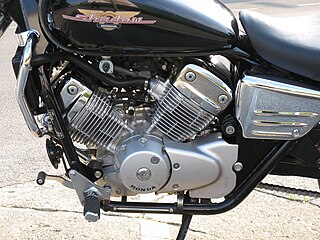
A V-twin engine, also called a V2 engine, is a two-cylinder piston engine where the cylinders share a common crankshaft and are arranged in a V configuration.

The Bristol Jupiter was a British nine-cylinder single-row piston radial engine built by the Bristol Aeroplane Company. Originally designed late in World War I and known as the Cosmos Jupiter, a lengthy series of upgrades and developments turned it into one of the finest engines of its era.

The radial engine is a reciprocating type internal combustion engine configuration in which the cylinders "radiate" outward from a central crankcase like the spokes of a wheel. It resembles a stylized star when viewed from the front, and is called a "star engine" in some languages. The radial configuration was commonly used for aircraft engines before gas turbine engines became predominant.

The Bristol Pegasus is a British nine-cylinder, single-row, air-cooled radial aero engine. Designed by Roy Fedden of the Bristol Aeroplane Company, it was used to power both civil and military aircraft of the 1930s and 1940s. Developed from the earlier Mercury and Jupiter engines, later variants could produce 1,000 horsepower (750 kW) from its capacity of 1,750 cubic inches by use of a geared supercharger.

The sleeve valve is a type of valve mechanism for piston engines, distinct from the usual poppet valve. Sleeve valve engines saw use in a number of pre-World War II luxury cars and in the United States in the Willys-Knight car and light truck. They subsequently fell from use due to advances in poppet-valve technology, including sodium cooling, and the Knight system double sleeve engine's tendency to burn a lot of lubricating oil or to seize due to lack of it. The Scottish Argyll company used its own, much simpler and more efficient, single sleeve system (Burt-McCollum) in its cars, a system which, after extensive development, saw substantial use in British aircraft engines of the 1940s, such as the Napier Sabre, Bristol Hercules, Centaurus, and the promising but never mass-produced Rolls-Royce Crecy, only to be supplanted by the jet engines.
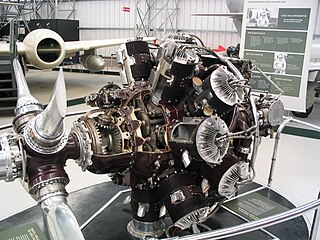
The Bristol Hercules was a 14-cylinder two-row radial aircraft engine designed by Sir Roy Fedden and produced by the Bristol Engine Company starting in 1939. It was the most numerous of their single sleeve valve designs, powering many aircraft in the mid-World War II timeframe.

The Napier Lion was a 12-cylinder, petrol-fueled 'broad arrow' W12 configuration aircraft engine built by D. Napier & Son from 1917 until the 1930s. A number of advanced features made it the most powerful engine of its day and kept it in production long after other contemporary designs had been superseded. It is particularly well known for its use in a number of racing designs, for aircraft, boats and cars.
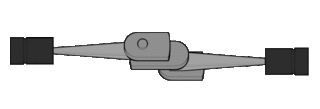
A flat engine, also known as a horizontally opposed engine, is a piston engine where the cylinders are located on either side of a central crankshaft. It is effectively a V engine with a 180-degree angle between the cylinder banks. A flat engine should not be confused with the opposed-piston engine, in which each cylinder has two pistons sharing a central combustion chamber.
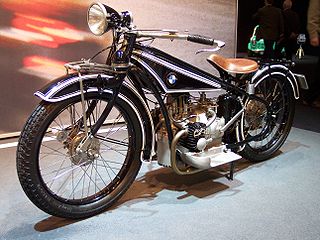
BMW's motorcycle history began in 1921 when the company commenced manufacturing engines for other companies. BMW's own motorcycles—sold under the BMW Motorrad brand—began in 1923 with the BMW R 32, which was powered by a flat-twin engine. Production of motorcycles with flat-twin engines continues to this day, however BMW has also produced many models with other types of engines.

In automotive design, an FR, or front-engine, rear-wheel-drive layout is one where the engine is located at the front of the vehicle and driven wheels are located at the rear. This was the traditional automobile layout for most of the 20th century. Modern designs commonly use the front-engine, front-wheel-drive layout (FF). It is also used in high-floor buses and school buses.
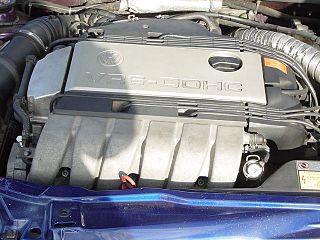
VR6 engines are V6 piston engines with a narrow angle between the cylinder banks and a single cylinder head covering both banks of cylinders.

The Knight engine is an internal combustion engine, designed by American Charles Yale Knight (1868-1940), that uses sleeve valves instead of the more common poppet valve construction.

The Handley Page W.8, W.9 and W.10 were British two- and three-engine medium-range biplane airliners designed and built by Handley Page.

BMW Motorrad is the motorcycle brand of the German company BMW, part of its Corporate and Brand Development division. It has produced motorcycles since 1923, and achieved record sales for the fifth year in succession in 2015. With a total of 136,963 vehicles sold in 2015, BMW registered a growth of 10.9% in sales in comparison with 2014. In May 2011, the 2,000,000th motorcycle produced by BMW Motorrad was an R1200GS.
Buda Engine was founded in 1881 by George Chalender in Buda, Illinois, to make equipment for railways. Later based in Harvey, Illinois, Buda from 1910 manufactured engines for industrial, truck, and marine applications. Early Buda engines were gasoline fueled. Later, diesel engines were introduced, utilizing proprietary Lanova cylinder head designs, injection pumps and nozzles. These were known as Buda-Lanova diesel engines. Buda Engine Company was acquired by Allis-Chalmers in 1953. The Buda-Lanova models were re-christened "Allis-Chalmers diesel".
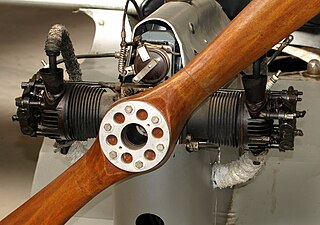
The ABC 8 hp is an 8 hp (6 kW) two-cylinder aero engine designed by the noted British engineer Granville Bradshaw for use in ultralight aircraft. The engine was derived from a specially tuned motorcycle unit and was built by ABC Motors, first running in 1923.
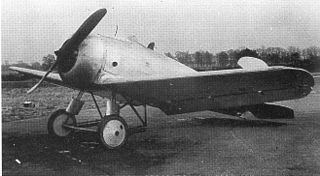
The Handley Page Type S, or HPS-1 was a prototype British carrier-based fighter developed for the United States Navy in the early 1920s. A low-wing monoplane, it was unsuccessful, only two being built and flown.
The Handley Page Type A, sometimes called "Bluebird" and later designated HP.1, was the first powered aircraft designed and built by Frederick Handley Page.

Willys was a brand name used by Willys–Overland Motors, an American automobile company best known for its design and production of military Jeeps (MBs) and civilian versions (CJs) during the 20th century.
References
| This article about classic and vintage automobiles produced between 1915 and 1930 is a stub. You can help Wikipedia by expanding it. |